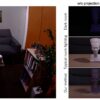Researchers from the University of Nebraska-Lincoln and the University of California, Berkeley, have developed a new photonic device that could get scientists closer to the “holy grail” of finding the global minimum of mathematical formulations at room temperature. Finding that illusive mathematical value would be a major advancement in opening new options for simulations involving quantum materials.
Many scientific questions depend heavily on being able to find that mathematical value, said Wei Bao, Nebraska assistant professor of electrical and computer engineering. The search can be challenging even for modern computers, especially when the dimensions of the parameters—commonly used in quantum physics—are extremely large.
Until now, researchers could only do this with polariton optimization devices at extremely low temperatures, close to about minus 270 degrees Celsius. Bao said the Nebraska-UC Berkeley team “has found a way to combine the advantages of light and matter at room temperature suitable for this great optimization challenge.”
The devices use quantum half-light and half-matter quasi-particles known as exciton-polaritons, which recently emerged as a solid-state analog photonic simulation platform for quantum physics such as Bose-Einstein condensation and complex XY spin models.
“Our breakthrough is enabled by adopting solution-grown halide perovskite, a famous material for solar cell communities, and growing it under nanoconfinement,” Bao said. “This will produce exceptional smooth single-crystalline large crystals with great optical homogeneity, previously never reported at room temperature for a polariton system.”
Bao is the corresponding author of a paper reporting this research, published in Nature Materials.
“This is exciting,” said Xiang Zhang, Bao’s collaborator, now president of Hong Kong University but who completed this research as a mechanical engineering faculty member at UC Berkeley. “We show that XY spin lattice with a large number of coherently coupled condensates that can be constructed as a lattice with a size up to 10×10.”
Its material properties also could enable future studies at room temperature rather than ultracold temperatures. Bao said, “We are just starting to explore the potential of a room temperature system for solving complex problems. Our work is a concrete step towards the long-sought room-temperature solid-state quantum simulation platform.
“The solution synthesis method we reported with excellent thickness control for large ultra-homogenous halide perovskite can enable many interesting studies at room temperature, without the need for complicated and expensive equipment and materials,” Bao added. It also opens the door for simulating large calculational approaches and many other device applications, previously inaccessible at room temperature.
This process is essential in the highly competitive era of quantum technologies, which are expected to transform the fields of information processing, sensing, communication, imaging and more.
Nebraska has prioritized quantum science and engineering as one of its Grand Challenges. It was named a research priority because of the university’s expertise in this area and the impact the research can make on the exciting and promising field.
More information:
Renjie Tao et al, Halide perovskites enable polaritonic XY spin Hamiltonian at room temperature, Nature Materials (2022). DOI: 10.1038/s41563-022-01276-4
Provided by
University of Nebraska-Lincoln
Citation:
New device gets scientists closer to quantum materials breakthrough (2022, June 17)



